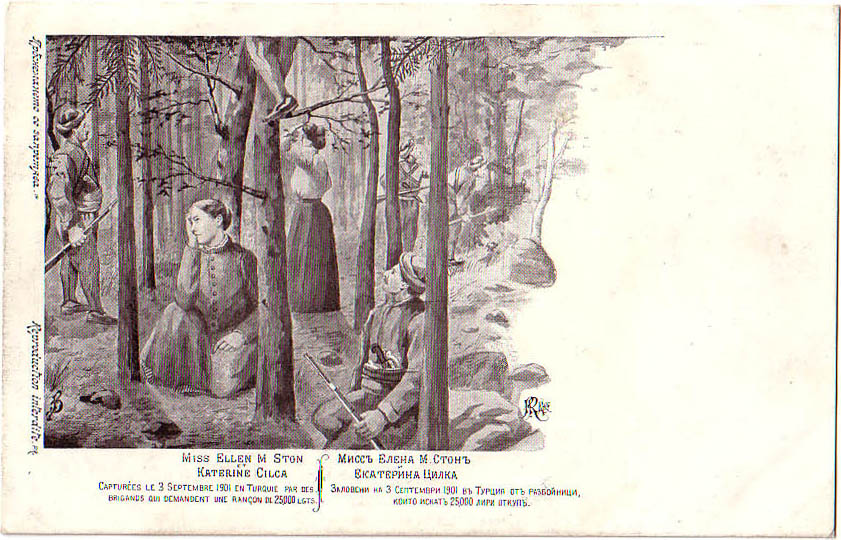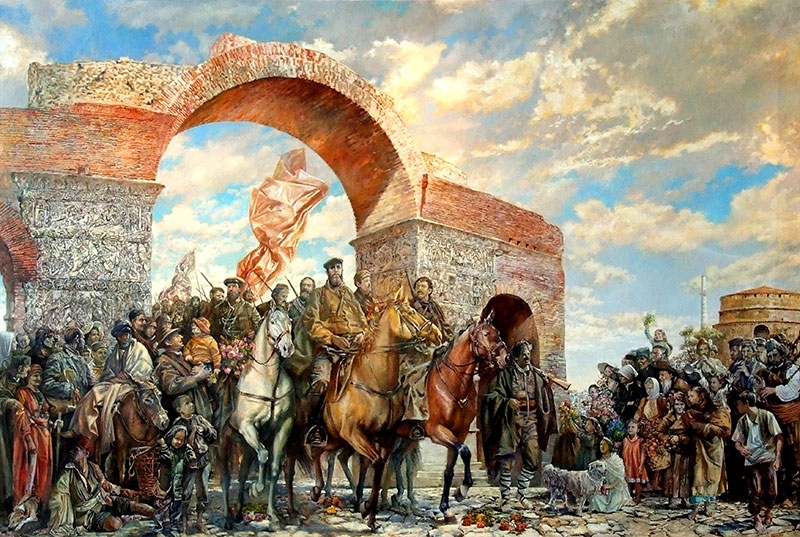Today marks the anniversary of the death of Macedonian revolutionary Jane Sandanski, a legendary commander of VMRO and the Macedonian struggle for freedom. Nicknamed “The Tsar of Pirin”, Jane was born around his namesake in the village of Vlahi, present-day Bulgaria. Even from an early age, Jane was steeped in a revolutionary milieu–his father was a leading figure in the local militia in the 1878 Kresna Uprising, which produced Macedonia’s first constitution. Even when playing a game of war as children, Jane would always take on the role of the Macedonian komita. However, the defeat of the uprising saw Jane’s family move to Dupnica, a town near Kyustendil, Bulgaria. Entering high school, as was the case for many Macedonians, was Jane’s formal exposure to the revolutionary ideas that spoke of an independent Macedonia–a home for all of Macedonia’s ethnic groups to live side-by-side in peace.
By 1892, as well-paying jobs within Macedonia were scarce, Jane joined the Bulgarian Army which helped to mold the patriotic mindset into a a skilled leader of military forces. Despite being a Macedonian in Bulgaria, he still remained connected to his homeland and the revolutionary movement starting within, To do his part, Jane formed a Macedonian youth organization called “Mladost”. Further exposure to VMRO (Internal Macedonian Revolutionary Organization), including a historic meeting with Goce Declev, saw Jane dedicate his life to the movement.

Recognizing his military prowess, Goce appointed Jane as military commander of Serress–a highly contested region often the scene of vicious pro-Bulgarian propaganda. However, as the village was relatively weak and impoverished, Jane took to alternative means to raise funding and awareness for the situation of Macedonians. In 1901, 18 komiti rebels under Jane’s command kidnapped Protestant missionary Miss Ellen Stone, and her friend Katerina Cilka. Dubbed America’s first international hostage situation, the event was widely circulated in Western media outlets. Most surprisingly, however, was that the hostages would eventually begin to sympathize with the movement and even celebrated the birth of Katrina’s daughter with the rebels–an early form of Stockholm syndrome. Evading both the Ottoman and Bulgarian Supremacist forces, the two were held by Jane’s komiti for about 6 months, after which they were released for a ransom of 14,000 Turkish lira.

By 1903, many leaders became dangerously confident that an armed uprising was finally achievable. Jane, following the Goce school of thought, adamantly disagreed and said the Macedonian population was not nearly prepared. Not wanting to cause dissent, Jane did not object to being overruled and he launched an attack on the Turkish forces in Serres during the ill-fated Ilinden Uprising. While the Aegean Macedonian regions saw more success in liberating territory, the nucleus of the revolution, Krusevo, fell within 10 days.
Jane, however, was quick to point out that such a defeat would create a vacuum that Macedonia’s neighbors could seek to exploit. By 1904, Jane had re-directed his fighting towards Bulgarian militias, often armed by the rival Supreme Macedonian Committee in Sofia. It was during this time that VMRO started factionalize around its relationship with Bulgaria. The conservatives, though in principle opposed to Bulgarian assistance began to accept as a necessity after the Ilinden uprising. The liberals headed by Jane, however, outright rejected all forms of aid from Bulgaria, and actively fought against their influence. Their views centered around the idea of an independent Macedonia, possibly part of a larger Balkan federation, but staunchly outside the realm of the Principality of Bulgaria. Another faction, the third so-called circle, was headed by Boris Sarafov, a former Supremacist member who advocated the use of terrorism and publicity to pursue the goals of the movement.
Seeing the turmoil both within VMRO and the Ottoman Empire, Sandanski directed his attention towards political activism and reform within the Ottoman Empire itself. He became integrated with the 1908 Young Turks Movement, which pushed for a series of reforms and a return to the 1878 Constitution which made all subjects Ottomans under the law. By doing so, everyone, regardless of their religion had the right to liberties such as freedom of press and free education. When Sultan Abdul Hamid II attempted to reverse his position on the constitution once more, Jane joined thousands of others in the wider Young Turk revolution on a march to Constantinople to overthrow the Sultan and replace him with his half-brother, who would be the last Sultan.
During the outbreak of the Balkan Wars, Jane again used his military prowess to organize the komiti. His forces captured many cities in the Pirin region, before finally joining “allied” Greek forces on a march to Salonica. Initially believing that Macedonia had been freed with the assistance of the Balkan states, reality soon took a turn for the force as Macedonians realized that the Greeks, Bulgarians, and Serbs did not intend to leave Macedonia after the removal of the Ottomans. Fighting soon broke out once more between the previous allies over the division of Macedonia, and launched the Second Balkan War.
Jane attempted to repel the new invaders, and even resorted to strategically using the Bulgarian army in many cases. With the final partition of Macedonia on August 10th, 1913, Jane retreated to his domain, the Pirin Mountain, fully encircled by new enemies. On April 22nd, 1915, Jane was ambushed on likely orders from the Bulgarian king Ferninand in mountains around the town of Nevrokop. The death of the Tsar was mourned by Macedonians all over, and his legacy and fight for an independent Macedonia remains enshrined in our folklore, songs, and memory.

His life-view on the long and continuous fight for Macedonia, both militarily and diplomatically, is summed up by his famous quote: “To live means to fight! The slave fights for freedom, and the free man for perfection!” 102 years later, we continue Jane’s fight for perfection in Macedonia.
—
The views of the author may not necessarily reflect the views of the United Macedonian Diaspora and Generation M.

